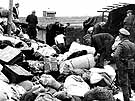
|
|
|

|

|

|

|
|
Click on an image to see a larger, more detailed picture.
|
|
|
|
|
| 1944: Desperate Acts |

|
pg. 525 |

|
|
|
|
| |
 Dwarfed by the mountain of shoes before them, women inmates at Auschwitz sort the footwear into piles according to size. Often the shoes would exist longer than the women who sorted them. After initial sorting, the shoes would be moved to "Canada," the storage depot. Then the women of the Schuhkommando (shoe detail) set to work, separating uppers from soles and leather from rubber. Most of the material was sent to Germany.
Dwarfed by the mountain of shoes before them, women inmates at Auschwitz sort the footwear into piles according to size. Often the shoes would exist longer than the women who sorted them. After initial sorting, the shoes would be moved to "Canada," the storage depot. Then the women of the Schuhkommando (shoe detail) set to work, separating uppers from soles and leather from rubber. Most of the material was sent to Germany.
Photo: Yad Vashem/United States Holocaust Memorial Museum Photo Archive
|
 The Aufräumungskommandos (cleaning commandos), most of whom were Jews, were given the ghoulish task of sorting through the belongings of the victims of Auschwitz's gas chambers. The camp's inmates referred to the several dozen barracks in which this material was stored as "Canada," associating them with the riches of that country.
The Aufräumungskommandos (cleaning commandos), most of whom were Jews, were given the ghoulish task of sorting through the belongings of the victims of Auschwitz's gas chambers. The camp's inmates referred to the several dozen barracks in which this material was stored as "Canada," associating them with the riches of that country.
Photo: Yad Vashem/United States Holocaust Memorial Museum Photo Archive
|
 "Canada"
"Canada"
While their victims perished in the gas chambers of Auschwitz-Birkenau, the Nazis plundered the personal belongings of the dead. In a special section of the Birkenau camp, work details of mainly Jewish women sorted the collected loot. This part of the camp became known as "Canada," sardonically likened to a country known for its riches and abundance. Day- and night-shift prisoner "commandos" systematically sorted and classified clothing, luggage, blankets, utensils, valuables, and food. Some prisoners sorted shoes, some only men's clothing. They separated suitcases, blankets, and even baby carriages and tossed them into huge piles. In the building known as the "feed barrack," great mounds of foodstuffs such as Hungarian salamis and Dutch cheese became moldy and rotten. Eager to find money and jewelry, the SS ordered prisoners to squeeze toothpaste into buckets in their search for hidden diamonds. Even such personal items as hair ribbons, watches, eyeglasses, and dentures were collected. Sorted booty was loaded onto trains and trucks and hauled to Germany. Forced to evacuate the camp in early 1945, the Nazis left behind 349,820 men's suits, 836,255 women's outfits, and approximately 38,000 pairs of men's shoes.
Photo: Yad Vashem / United States Holocaust Memorial Museum Photo Archive
|
|

|

|

|

|
 May 13, 1944: The Red Army captures Sevastopol, Ukraine.
May 13, 1944: The Red Army captures Sevastopol, Ukraine.
|
 May 13, 1944: Throughout the Nazi camp system, inmate tattoo numbers gain a new series, prefaced with the letter "A." The intention is to conceal the number of prisoners at Auschwitz.
May 13, 1944: Throughout the Nazi camp system, inmate tattoo numbers gain a new series, prefaced with the letter "A." The intention is to conceal the number of prisoners at Auschwitz.
|
 May 15, 1944: Germans begin deportations of Hungarian Jews to Auschwitz from Ruthenia and northern Transylvania.
May 15, 1944: Germans begin deportations of Hungarian Jews to Auschwitz from Ruthenia and northern Transylvania.
|
 May 15, 1944: 878 Jews are deported from Drancy, France, to the Reval, Estonia, slave-labor camp.
May 15, 1944: 878 Jews are deported from Drancy, France, to the Reval, Estonia, slave-labor camp.
|
 May 15-July 9, 1944: More than 430,000 Jews are deported to Auschwitz. Up to 100 are crammed into individual boxcars, with a single water bucket and a single bucket for waste. Suicide and insanity are rampant during transports.
May 15-July 9, 1944: More than 430,000 Jews are deported to Auschwitz. Up to 100 are crammed into individual boxcars, with a single water bucket and a single bucket for waste. Suicide and insanity are rampant during transports.
|
 May 18, 1944: Jewish partisan leader Aleksander Skotnicki is killed as his unit battles the armored SS Viking Division near the Parczew Forest in Poland.
May 18, 1944: Jewish partisan leader Aleksander Skotnicki is killed as his unit battles the armored SS Viking Division near the Parczew Forest in Poland.
|
 May 18, 1944: A deportation train from Paris arrives at Kovno, Lithuania; See May 19, 1944.
May 18, 1944: A deportation train from Paris arrives at Kovno, Lithuania; See May 19, 1944.
|
|
|
|
|
| 1944: Desperate Acts |

|
pg. 525 |

|
|
The Holocaust Chronicle
© 2009 Publications International, Ltd.
|
|
